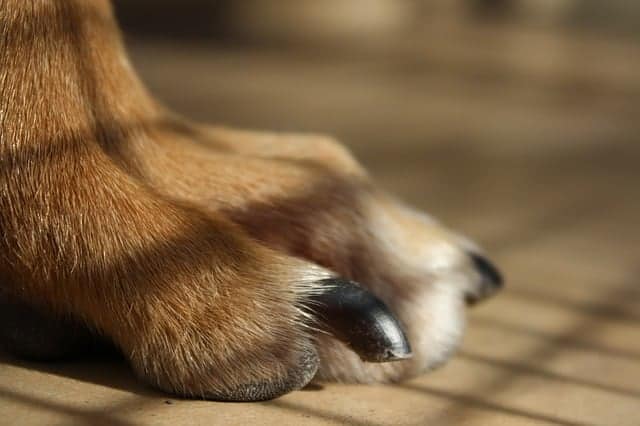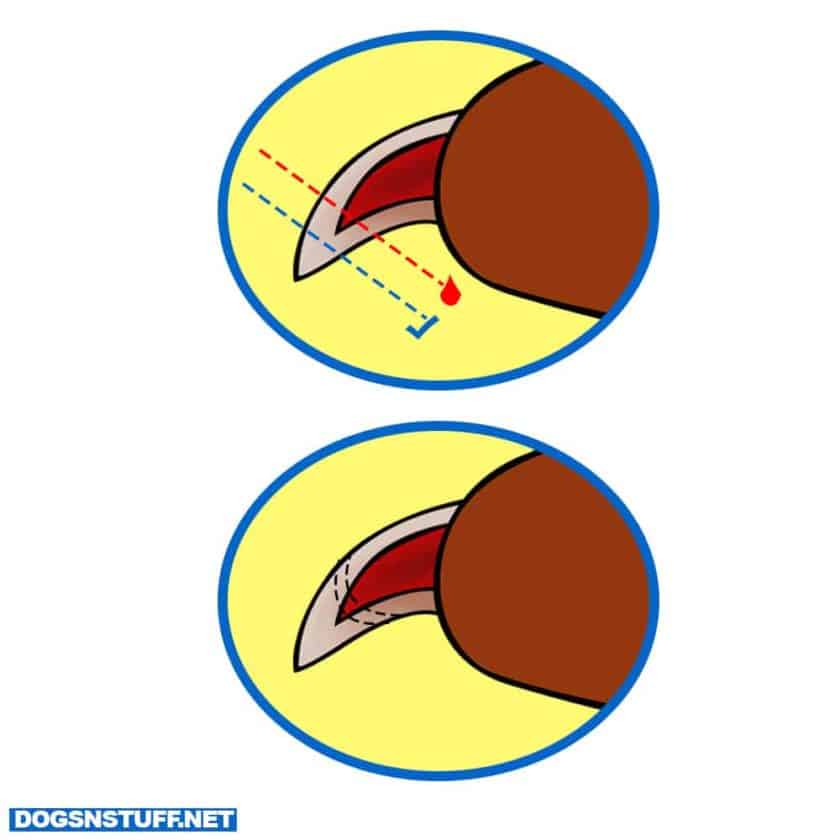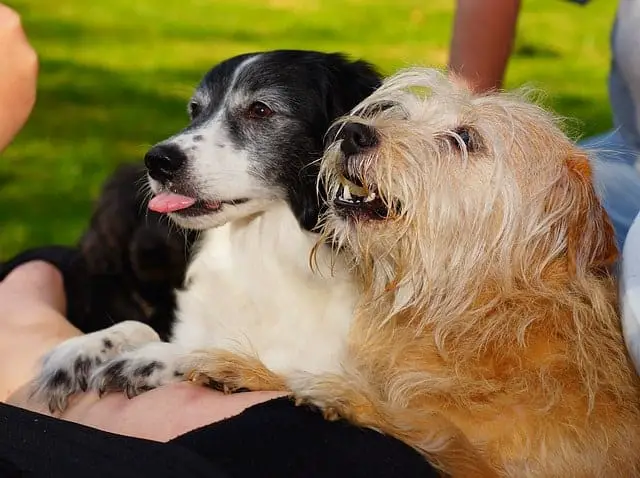Just like with your own nails, your dog’s nails must be trimmed and cut regularly lest they become overgrown.
For pet owners, dog nails that are overgrown can become unsightly and can make playtime a bit of a challenge because of the possibility of you getting scratched by your dog.
But if you haven’t trimmed your dog’s nails in a while, don’t feel too bad about it.
You’re not the first one to do it. If you don’t know how to trim dog nails that have overgrown, then you’re just in the right place to know-how.
Table of Contents
Why trimming overgrown dog nails is important

Your dog will feel much better without the discomfort of having overgrown nails.
This is because a dog’s nail will only continue to grow and the added lead can lead to pain.
Overgrown nails in a dog will eventually sag causing hurt to their paws.
Just like in the case with people, overgrown dog nails are like an ingrown that can cause pain and infection – two things that you definitely want to avoid with your dogs.
Another reason why you have to trim your dog’s nails is that an overgrown nail can get caught on textiles like a carpet around your house.
Nail trimming among dogs
Honestly, dogs and puppies alike are not a fan of nail trimming.
The only way your dogs or puppies will like it when you trim their nails is when you make the experience a positive one for them.
Most of the time, your canine friends will dislike having their overgrown nails trimmed because it caused them pain in the process.
The good news is that if you keep your dog’s nails trimmed, then you don’t have to do it as often as you would a human nail.
A regular walk on the pavement is also a natural ways to keep your dog’s nails short and trimmed.
How to trim dog nails that are overgrown
The process of trimming overgrown dog nails can become a challenge for most pet owners.
If you cut too deep, your dog’s nails might bleed. Accidents also happen when you clip your dog’s nails and they’re agitated or totally scared of getting their nails trimmed.
Just like any other routine, though, you can train your dogs to tolerate the process of nail trimming and do everything you can to make the experience pleasant and not overly painful for them as it sometimes cannot be avoided.
Here are the two important things you need to do first before you go to the actual process of trimming overgrown dog nails step-by-step:
Make sure that you choose and use the right trimming materials
Dog nails are different than humans so a regular nail cutter won’t cut it for your furry buddy.
Dogs have thicker nails with a cylindrical shape so make sure that you use nail clippers specifically made for dogs.
There are a variety of options to choose from like the guillotine utensil which is best for beginners, the scissor-type nail clipper fit for short dog claws, and the clamp type nail clipper often used by vets and pet grooming professionals because of its ease of use and durability to stay sharp for a long time.
Make dog pedicure a habit
As soon as you bring your pup home, make sure to immediately introduce them to nail trimming so that they’ll get used to it as they grow.
A dog that has grown with the feeling of having its paws touched while young is more likely to feel comfortable having their nails trimmed.
You can also play with your puppy’s or dog’s paws first so they would associate nail trimming as play and be eager for it.
You can also give them a treat if they respond well to nail trimming to make this same routine easier to do in the future.
Step by step process on how to cut overgrown dog nails
Length of time: 20-30 minutes (or more if needed)
Step 1. Carefully position your dog or puppy for the nail trimming. Make sure that your dog won’t bite you or twist suddenly while you’re doing the trimming.

It’s advisable to have somebody else with you, especially if you have a large dog, to pet it or talk to your dog. For a much smaller dog, you can do it alone by holding its body with one hand and its paw on the other hand.
Step 2. Make sure you place the nail clippers properly on your dog’s nails at a 45-degree angle.

Cut your dog’s nails until you see the thin pink fiber which is easier to see on dogs with lighter nails.
For dogs with dark-colored nails, do the cutting little by little until you see the pink fiber.
Don’t cut beyond this part because doing so would cause pain and bleed for your dog.

Step 3. Don’t rush trimming your dog’s overgrown nails to avoid accidents. Rushing can also make your dog agitated or scared during the process.
For every nail that you clip successfully and your dog behaves nicely, reward them with a treat so they’d treat the nail trimming as a game.

Step 5. Just repeat the process until you get to trim all of your dog’s overgrown nails.
Things to remember
- Tire out your dog before doing their pedicure so that they’ll be less agitated in the process.
- Before you introduce your dogs to nail clipping, make sure that you touch their paws frequently so they’ll know that you do not mean them harm.
- Dog’s paws are sensitive so applying too much pressure with your hands and with the nail clippers is not recommended.
In case of bleeding because you miscalculated the length of dog nail you should cut, apply pressure on the bleeding nail, put styptic powder, and a bandage to your dog’s paw.
Once the bleeding stops, carefully remove the bandage. If the bleeding becomes too heavy, go and see your vet right away.
How often should you cut overgrown dog nails?
Every time! In fact, you shouldn’t wait for your dog’s nails to be overgrown before you trim them.
Some dog’s nails grow faster than other dogs and some don’t need much trimming at all because they have a faster rate of natural wear due to constantly walking on pavement.
Trimming your dog’s nails once a month or every two months is the general practice among most dogs.
Of course, you can also do a visual check to see if your dog’s nails need trimming since the nails on the forepaws of your dog grow faster than its hind paws.
Trimming your dog’s overgrown nails can really become a challenge for both pet owners and your canine buddy.
But once you trained your puppy or dog to the process and make this routine a relaxing and playful time for them, then trimming overgrown dog nails wouldn’t have to be as stressful.
Frequently Asked Questions
What is the easiest way to trim dog nails?
Whether you’ve been a dog owner for years or you’re planning on making the leap, one of the most common ailments that all dog owners seem to encounter is nail trimming!
More often than not, no matter how great the bond might be between dog and owner, nail trimming can be a nerve-racking and scary experience for both, especially as many dogs can become anxious while getting their nails trimmed.
Generally speaking, nail trimming may not always be a necessary part of your dog’s grooming routine. If your dog is very active and loves to run around and play for large parts of its day, then you likely will find that you do not need to trim down your dog’s nails yourself, as they will be wearing them down naturally.
In addition to this, nail trimming may also not be necessary if you regularly walk your dog along with a variety of surfaces such as concrete.
However, if you are noticing that your dog has relatively long nails, then you will need to give them a trim. Below, follow the steps for the easiest and most comfortable trimming method for both you and your dog:
- Begin by gently smoothing your dog and making sure that your dog feels comfortable and relaxed. Then, when you feel that your dog is comfortable, gently bring out the clippers and allow your dog to inspect them so that your dog will not be fearful of them. All the while, make sure that you are using lots of praise – you could even give your dog a treat, too.
- Once your dog is relaxed and comfortable with the presence of the clippers, then you can then proceed to begin the process of clipping. Take one of your dog’s paws and hold it firmly yet gently, and then begin to cut the nail right below the quick at a 45-degree angle.
- While you are trimming, make sure that you are talking to your dog and making sure that he feels comfortable. Then, as soon as you see the white right inside the nail with a little black/brown dot in the center, you should then stop. However, if you do not yet see the white, then you can proceed to cut a little bit more. Remember, while you are trimming your dog’s nails it is very important to start off slow and cut in small, gradual amounts – otherwise you might catch the quick, which is something that you certainly don’t want to do at any point.
How do you know where the quick is on black dog nails?
If your breed of dog has black nails, then we’re sure you know how off-putting it can be to try to trim them – especially because the quick is very difficult to spot. Luckily, the good news is that trimming dogs with black nails is relatively easy, so long as you know the correct technique.
So, in order to ensure that you don’t catch the quick while trimming your dog’s black nails, gently lift up your dog’s paw while trimming so that you can see the center of the unclipped nail face-on.
Then, begin gently and slowly clipping the nail in small increments until you see a small white color on the cut surface, as this is the pulp. Once you see this, it means that you have cut the nails as far as they can go.
Is it better to cut or grind dog nails?
While both of these nail trimming methods are very effective, the answer to this question will ultimately come down to what feels most comfortable for you and your dog.
Most owners do find that using a grinding tool is the best way to maintain their dog’s nails, as it gives them more control over spotting the quick. However, grinding does often mean that owners have to maintain their dog’s nails more frequently, than if they were to trim with clippers.
On the other hand, clippers are the traditional method of trimming nails, although many owners feel nervous about clipping their dog’s nails, in case they accidentally catch the quick.
If you are planning on using clippers, then we recommend cutting in very small increments, in order to avoid catching the quick. Once you see a little white dot, this means that you need to stop.
How long should a dog’s nails be?
Good question! Though the ideal length of a dog’s nails will very much depend on each individual dog, some general guidelines to keep in mind is that your dog’s claws should never protrude over their pads, and they should also not touch the ground while they are standing in a normal stance.
Can I file my dog’s nails instead of clipping them?
Yes, you can! One of the most popular alternatives to using nail clippers is to use a grinding tool that will be able to file down the nails. Many dog owners prefer to use this method if they have a dog who is afraid of nail clippers, as well as for dog owners who are anxious about nail trimming and would like a less invasive method that will reduce the chances of catching the quick.
If you’d like a recommendation, then the Cafuy Dog Nail Grinder is one of the best on the market and is suitable for a wide variety of dogs, including small, medium, and large breeds.
What angle do you cut dogs’ nails?
As a general rule of thumb, you should ensure that you are cutting your dog’s nails at a 45-degree angle, as this is the safest way to cut your dog’s nails. In addition to this, we also strongly recommend that you hold your dog’s paws within close proximity to your face and make sure that you are viewing the nails head-on, as this will ensure you are able to correctly cut the nails, as well as prevent accidentally catching the wick!
Can a dog die from cutting the quick?
Though it is possible for a dog to die from accidentally cutting the quick, this scenario is very rare and highly unlikely in healthy dogs. If you were to cut your dog’s nail quickly on accident, then the initial flow of blood will more than likely make the situation appear to be a lot worse than it actually is.
In reality, when a dog’s quick is cut, it will usually bleed profusely for a few moments, and then gradually begin to slow down. In addition to this, the dog’s body will usually be able to then begin the healing process without the need for urgent medical attention.
However, if you do own a sickly dog or even an older dog, then you may need to consider taking your dog to a veterinarian immediately after cutting the quick, as in these instances, there is a higher risk of the dog’s body being unable to slow the flow and begin the repair process.
Do dogs feel pain when you cut their nails?
Just like us, trimming the nails is usually a pain-free procedure. Although, if the nails are damaged or too long, then it can be uncomfortable and even potentially painful for your dog to sit through. In addition to this, if the quick is accidentally caught, then this will most definitely cause pain and bleeding.
Needless to say, so long as you are ensuring that you are regularly keeping on top of your dog’s mail and maintaining them, then the trimming procedure will not hurt your dog or cause your dog to feel any pain.
Does walking your dog trim their nails?
Yes, regular walking can help to naturally grind down your dog’s nails. However, you will need to make sure that you are walking your dog on a variety of both soft and hard surfaces for the best results.

